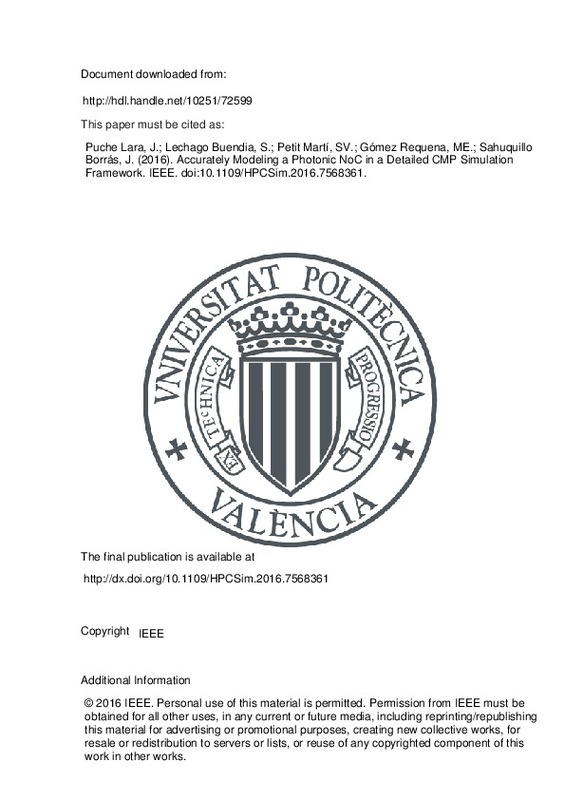Puche Lara, J.; Lechago Buendía, S.; Petit Martí, SV.; Gómez Requena, ME.; Sahuquillo Borrás, J. (2016). Accurately Modeling a Photonic NoC in a Detailed CMP Simulation Framework. IEEE. https://doi.org/10.1109/HPCSim.2016.7568361
Por favor, use este identificador para citar o enlazar este ítem: http://hdl.handle.net/10251/72599
|
Título:
|
Accurately Modeling a Photonic NoC in a Detailed CMP Simulation Framework
|
|
Autor:
|
Puche Lara, José
 Lechago Buendía, Sergio
Lechago Buendía, Sergio

 Petit Martí, Salvador Vicente
Petit Martí, Salvador Vicente

 Gómez Requena, María Engracia
Gómez Requena, María Engracia

 Sahuquillo Borrás, Julio
Sahuquillo Borrás, Julio
|
|
Entidad UPV:
|
Universitat Politècnica de València. Departamento de Informática de Sistemas y Computadores - Departament d'Informàtica de Sistemes i Computadors
Universitat Politècnica de València. Escola Tècnica Superior d'Enginyeria Informàtica
Universitat Politècnica de València. Instituto Universitario de Tecnología Nanofotónica - Institut Universitari de Tecnologia Nanofotònica
|
|
Fecha difusión:
|
|
|
Resumen:
|
Photonic interconnects are a promising solution for the so-called communication bottleneck in current Chip Multiprocessor (CMPs) architectures. This technology presents an inherent low-latency and power consumption almost ...[+]
Photonic interconnects are a promising solution for the so-called communication bottleneck in current Chip Multiprocessor (CMPs) architectures. This technology presents an inherent low-latency and power consumption almost independent of communication distance, which are really desirable features in future Networks on Chip for next CMPs generations.
However, since nanophotonic technology is still growing and therefore in an immature state, current simulators of detailed systems may not provide accurate models of photonic components. In this context, non-representative results are obtained when unaccurate photonic models are assumed.
This paper summarizes all of the components that conform a fully operative photonic NoC and presents their current state of the art. Moreover, we evaluate a realistic photonic network that consists of two photonic rings and a token-based arbitration mechanism and compare it against a non-realistic model. In addition, both realistic and non-realistic schemes are valuated under different configurations varying the number of wavelengths that photonic waveguides employ. The experimental results show that the non-realistic NoC presents up 6× network latency deviation with respect to the accurate model. This deviation is translated into a performance deviation higher than 10% in several applications studied, which demonstrates the importance of accurate models when simulating current technologies under development like nanophotonics.
Finally, a power consumption model of the realistic photonic network is presented. The results show that the overall photonic network power consumption grows with the number of wavelengths per waveguide since the number of required modulators and receivers becomes higher. In this way, the proposed realistic photonic network, which employs only two wavelengths for arbitration and destination selection tasks, increases its power consumption up to 3%, so network designs with more complex arbitration mechanisms must take into account the impact of the number of wavelengths on the power consumption.
[-]
|
|
Palabras clave:
|
Nanophotonics
,
NoC
,
Simulation Frameworks
|
|
Derechos de uso:
|
Reserva de todos los derechos
|
|
ISBN:
|
978-1-5090-2088-1
|
|
DOI:
|
10.1109/HPCSim.2016.7568361
|
|
Editorial:
|
IEEE
|
|
Versión del editor:
|
http://dx.doi.org/10.1109/HPCSim.2016.7568361
|
|
Título del congreso:
|
International Conference on High Performance Computing & Simulation (HPCS 2016)
|
|
Lugar del congreso:
|
Innsbruck, Austria
|
|
Fecha congreso:
|
July 28-22, 2016
|
|
Código del Proyecto:
|
info:eu-repo/grantAgreement/MINECO//TIN2015-66972-C5-1-R/ES/TECNICAS PARA LA MEJORA DE LAS PRESTACIONES, COSTE Y CONSUMO DE ENERGIA DE LOS SERVIDORES/
info:eu-repo/grantAgreement/EC/H2020/671553/EU/European Exascale System Interconnect and Storage/
|
|
Descripción:
|
© 2016 IEEE. Personal use of this material is permitted. Permission from IEEE must be obtained for all other uses, in any current or future media, including reprinting/republishing this material for advertising or promotional purposes, creating new collective works, for resale or redistribution to servers or lists, or reuse of any copyrighted component of this work in other works.
|
|
Agradecimientos:
|
This work was supported by the Spanish Ministerio de Economía y Competitividad (MINECO) and by Plan E funds under Grant TIN2015-66972-C5-1-R and the ExaNest project, funded by the European Union’s Horizon 2020 research ...[+]
This work was supported by the Spanish Ministerio de Economía y Competitividad (MINECO) and by Plan E funds under Grant TIN2015-66972-C5-1-R and the ExaNest project, funded by the European Union’s Horizon 2020 research andinnovation programme under grant agreement No 671553.
[-]
|
|
Tipo:
|
Comunicación en congreso
|







![[Cerrado]](/themes/UPV/images/candado.png)


